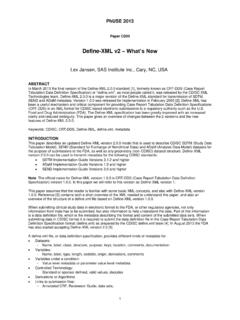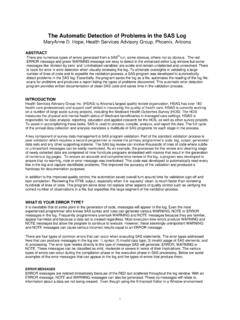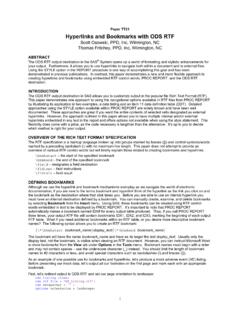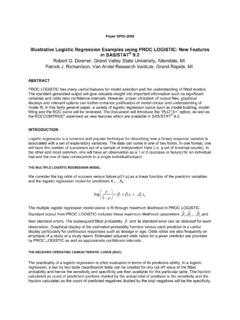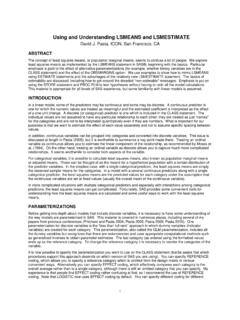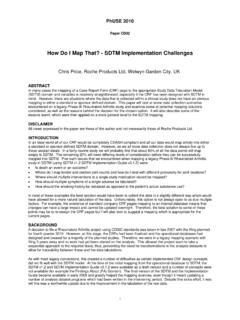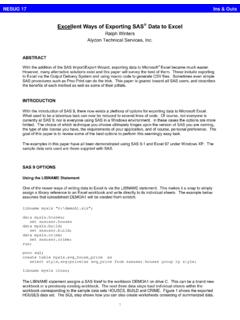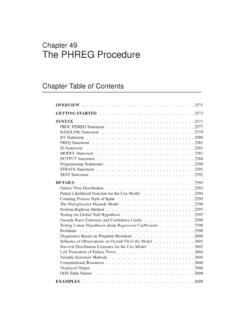Transcription of A Step-by-Step Guide to Survival Analysis
1 A Step-by-Step Guide to Survival Analysis Lida Gharibvand, University of California, Riverside ABSTRACT Survival Analysis involves the modeling of time-to-event data whereby death or failure is considered an "event". The graphical presentation of Survival Analysis is a significant tool to facilitate a clear understanding of the underlying events. In particular, the graphical presentation of Cox s proportional hazards model using SAS phreg is important for data exploration in Survival Analysis . In this paper, we will present a comprehensive set of tools and plots to implement Survival Analysis and Cox s proportional hazard functions in a Step-by-Step manner. We will demonstrate the features of SAS PROC LIFEREG, PROC LIFETEST, PROC phreg , PROC BPHREG, estimated hazard function, Survival function, advanced features of phreg , and selecting the best candidate models in model selection. A method will be outlined to perform all possible subset model selection within user-defined subsets using AIC information criterion.
2 The new user-friendly features of BPHREG, an experimental upgrade to phreg procedure, such as class , hazards ratio , and strata statements will be covered. The cumulative residuals from PROC phreg are used to investigate the model specification error of covariate and validate the proportion hazard function. Finally, the methods to identify outliers are commonly based on Cox regression residuals such as Martingale and deviance residuals which will be demonstrated using PROC GPLOT in SAS/GRAPH. INTRODUCTION Survival Analysis is the phrase used to describe the Analysis of data in the form of times from a well-defined time origin until the occurrence of some particular event or end-point . In medical research, the time origin often corresponds to the recruitment of an individual into an experimental study, such as a clinical trial to compare two or more treatments. This in turn may coincide with the diagnosis of a particular condition, the commencement of a treatment regiment, or the occurrence of some adverse event.
3 If the end point is the death of a patient, the resulting data are literally Survival times. However, data of a similar form can be obtained when the end-point is not fatal, such as the relief of pain, or the recurrence of symptoms. In this case, the observations are often referred to as time to event data. The Analysis of Survival data requires special techniques because the data are almost always incomplete and familiar parametric assumptions may be unjustifiable. Investigators follow subjects until they reach a pre-specified endpoint (for example, death). However, subjects sometimes withdraw from a study, or the study is completed before the endpoint is reached. In these cases, the Survival times (also known as failure times) are censored; subjects survived to a certain time beyond which their status is unknown. The uncensored Survival times are sometimes referred to as event times. Methods for Survival Analysis must account for both censored and uncensored data.
4 This paper is focusing on PROC LIFEREG, PROC LIFETEST, PROC phreg and PROC BPHREG which are important tools to analyze Survival data. This paper also demonstrates some sophisticated graphics made possible by the new SAS ODS Statistical Graphics capability. Survival DATA The actual data from Mayo liver disease example of Lin, Wei, and Ying (1993) is used here to demonstrate the features. The data consists of 418 patients with Primary Biliary Cirrhosis (PBC), among which 161 had died as of the date of data listing. The data set contains the following variables: Time Follow-up time in years Censor Event indicator with value 1 for death time and value 0 for censored time Age Age in years from birth to study registration Alb Serum albumin level in gm/dl Bili Serum Bilirubin level in mg/dl Edema Edema with value 0 for presence of no Edema, Edema with value for untreated or successfully treated, and Edema with value 1 for unsuccessfully treated Edema Protime Prothrombin time in seconds 1 SAS PROCS: There are three important SAS procedures available for analyzing Survival data: LIFEREG, LIFETEST and phreg (BPHREG).
5 PROC LIFEREG is a parametric regression procedure for modeling the distribution of Survival time with a set of concomitant variables (SAS Institute, Inc. (2007a)). PROC LIFETEST is a nonparametric procedure for estimating the survivor function, comparing the underlying Survival curves of two or more samples, and testing the association of Survival time with other variables (SAS Institute, Inc. (2007b)). PROC phreg is a semi-parametric procedure that fits the Cox proportional hazards model (SAS Institute, Inc. (2007c)). PROC BPHREG is an experimental upgrade to phreg procedure that can be used to fit Bayesian Cox proportional hazards model (SAS Institute, Inc. (2007d)). PROC LIFEREG The LIFEREG procedure fits parametric accelerated failure time models to Survival data that may be left, right, or interval censored. The parametric model is of the form + =Xy where y is usually the log of the failure time variable, x is a vector of covariate values, is a vector of unknown regression parameters, is an unknown scale parameter, and is an error term.
6 The distribution of the random disturbance can be taken from a class of distributions that includes the extreme value, normal, logistic, and, by using a log transformation, the exponential, Weibull, lognormal, loglogistic, and three-parameter gamma distributions. These models are equivalent to accelerated failure time models when the log of the response is the quantity being modeled. The accelerated failure time model assumes a parametric form for the effects of the explanatory variables and usually assumes a parametric form for the underlying survivor function that the effect of covariates on an event time distribution is multiplicative on the event time. The LIFEREG Procedure can be also used to perform a Tobit Analysis , a regression model for left-censored data assuming a normally distributed error term. For more information on LIFEREG refer the SAS Institute on-line documentation (SAS Institute, Inc. (2007a)). There is no ODS Graphics feature available in PROC LIFEREG (version ).
7 However we can generate the Survival probability plot using the PROBPLOT option. The following example demonstrates how you can use the LIFEREG procedure to fit a parametric model to failure time data. Consider fitting the Survival time of the PBC patients with covariates Bili, log(Protime), log(Alb), Age and Edema. The log transform, which is often applied to blood chemistry measurements, is deliberately not employed for Bili. It is of interest to assess the functional form of the variable Bili in the failure time data model. Please refer to Code Box 1. ODS RTF FILE='path\ 'style=statistical; ODS LISTING CLOSE; DATA pbc; GOPTIONS RESET=all COLORS=(Black, RED,BLUE,YELLOW,GREEN,MAGENTA,CYAN) dev=EMF target=EMF XMAX=7 YMAX=7 HTEXT=14pt FTEXT="<ttf> Arial"; PROC LIFEREG DATA=pbc; CLASS Edema; MODEL time*Censor(0)= Age logAlb logProtime Bili Edema; PROBPLOT Cencolor=red cframe=ligr cfit=blue ppout npintervals=simul; INSET / cfill = white ctext = blue; RUN; Code Box 1: PROC LIFEREG Code The PROC LIFEREG statement invokes the LIFEREG procedure.
8 The MODEL statement is required and specifies the variables used in the regression part of the model as well as the distribution used for the error, or random, component of the model (The default distribution used is Weibull and this can be changed for a better fit). Only a single MODEL statement can be used with one invocation of the LIFEREG procedure. If multiple MODEL statements are present, only the last model is used. Main effects and interaction terms can be specified in the MODEL statement, similar to the GLM procedure. Initial values can be specified in the MODEL statement or in an INEST= data set. If no initial values are specified, the starting estimates are obtained by ordinary least squares. Categorical variables can be specified in CLASS statement. Survival probability plot can be generated with PROBPLOT. Executing the code above will produce the following plot. 2 Follow-up Tim e in Censored Level95%Distribution Weibull Figure 1: Survival Plot Produced by LIFEREG Procedure The resulting graphical output is shown in Figure 1.
9 The estimated CDF, a line representing the maximum likelihood fit, and point wise parametric confidence bands are plotted here. The values of right-censored observations are plotted along the top of the graph. Figure 1 assesses the quality of the model fit. As we can see, the model fit is not very satisfactory. We will show how to improve the model fit in this paper. PROC LIFETEST The LIFETEST procedure can be used to compute nonparametric estimates of the survivor function either by the product-limit method (also called the Kaplan-Meier method) or by the life-table method (also called the actuarial method), comparing the underlying Survival curves of two or more samples, and testing the association of Survival time with other variables. PROC LIFETEST provides non-parametric k-sample tests based on weighted comparisons of the estimated hazard rate of the individual population under the null and alternative hypotheses. This proc also computes the rank tests and a likelihood ratio test for testing the homogeneity of Survival functions across strata.
10 The ODS GRAPHICS features are available in PROC LIFETEST. ODS GRAPHICS ON will add statistical graphics to the output. The simplest use of PROC LIFETEST is to request the nonparametric estimates of the survivor function for a sample of Survival times. In such a case, only the PROC LIFETEST statement and the TIME statement are required. All statements except the TIME ODS RTF FILE='path\ 'style=statistical; ODS LISTING CLOSE; ODS GRAPHICS on; DATA pbc; PROC LIFETEST DATA=pbc; TIME Time*Censor(0); Survival out=Out1 confband=all bandmin=100 bandmax=600 MAXTIME=800 conftype=asinsqrt PLOTS=(stratum, Survival , hwb); STRATA Edema; TEST Age logAlb logProtime Bili; RUN; ODS GRAPHICS OFF; ODS RTF CLOSE; ODS LISTING; QUIT; Code Box 2: PROC LIFETEST Code 3 All statements except the TIME statement are optional, and there is no required order for the statements following the PROC LIFETEST statement. Please refer to Code Box 2.
